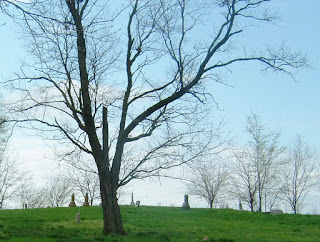Remember Wesley Tabscott/Tapscott? He was that illiterate fellow who lived in Clark County, Illinois, the last half of the 19th century and whose origins were completely unknown (postings 6/7/2015 and 8/6/2015). We knew his birth date and place, death date and place, military record, land holdings, varied name spellings, all sorts of things. Most everything, in fact, except who his parents were. Was he an unknown child of Henry Tapscott, the Traveler, who founded the Wabash Valley Tapscotts? Or a child of Henry's father, William the Preacher? Or perhaps a descendant of William's second cousin Raleigh Tapscott, who lived in Kentucky near William, a descendant who tagged along with Henry when he traveled to Clark County. Perhaps he was really James W. Tapscott, a son of Henry about whom we knew little, though this seemed highly unlikely. James was believed to be literate. Or perhaps he was was not a Tapscott at all, a product of an NPE, non-paternal event - a name change, an
illegitimate birth, an adoption. But the brick wall remained ... until Wed 27 Dec 2017, at precisely 2 PM, when it fell with a resounding crash.
 At
that date and time, while visiting my son, Michael, in Phoenix, and looking
through copies of old Clark County deeds, I saw something surprising. On 19 Feb
1877 for $600 Wesley Tapscott had purchased Lots 2, 3, 8, 9, Block 19, in the
town of Auburn (today, Clark Center). A few months shy of three years later, on 2 Dec 1879, those exact lots at that same
price were sold to a Susan Tapscott (presumably James's mother) by
James W. Tapscott, son of Henry the Traveler and Susan (Bass) Tapscott. Between the two
sales dates, no record is found showing the sale of land by Wesley to
James. Moreover, the latter deed of sale was signed with a mark. Like Wesley, James
was illiterate! Suddenly, everything fell into place. James W. Tapscott and Wesley Tabscott were one and the same, presumably James Wesley
Tapscott.
At
that date and time, while visiting my son, Michael, in Phoenix, and looking
through copies of old Clark County deeds, I saw something surprising. On 19 Feb
1877 for $600 Wesley Tapscott had purchased Lots 2, 3, 8, 9, Block 19, in the
town of Auburn (today, Clark Center). A few months shy of three years later, on 2 Dec 1879, those exact lots at that same
price were sold to a Susan Tapscott (presumably James's mother) by
James W. Tapscott, son of Henry the Traveler and Susan (Bass) Tapscott. Between the two
sales dates, no record is found showing the sale of land by Wesley to
James. Moreover, the latter deed of sale was signed with a mark. Like Wesley, James
was illiterate! Suddenly, everything fell into place. James W. Tapscott and Wesley Tabscott were one and the same, presumably James Wesley
Tapscott.
The
1850 and 1870 Clark County, Illinois, censuses showed the name “James W.” or just "James," because
that is how his family knew him and he was living with his mother and father
(Henry and Susan Tapscott) at the time. The name “James W. Tapscott” was entered
for his mark in the deed of sale to Susan Tapscott because the justice of the
peace acknowledging the signature was James’s brother William Tapscott, who,
like the rest of his immediate family, used that name. The occupation “at home”
shown for James in the 1870 census is that which was often shown in censuses for
nonworking invalids or near-invalids, as Wesley certainly was. Early records, 1852 and 1853 Federal land purchase documents, show the name "James W.," but he became "Wesley" in the military and continued using his middle name throughout
his life. At last, the mystery of
Wesley is solved. And from knowing little of James W. Tapscott, we now know a
lot.

























